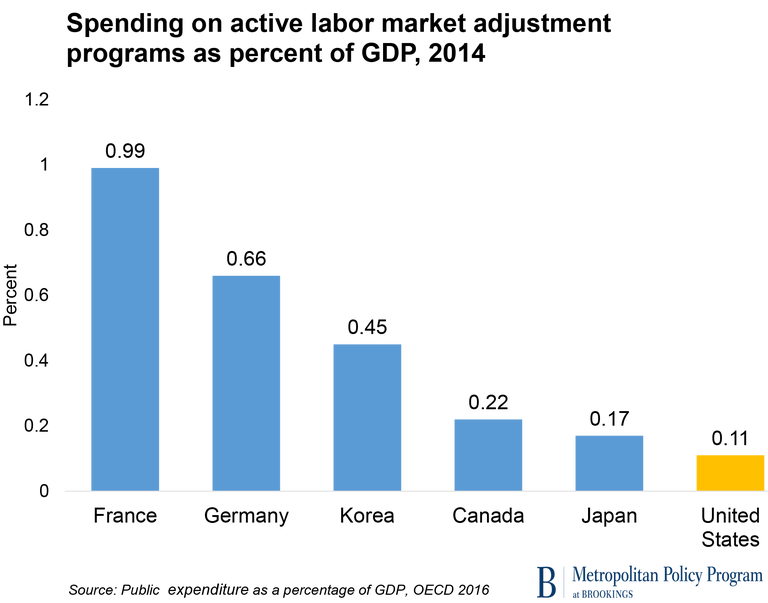For decades, American workers could expect to work at the same company for 50 years before retiring at 65 with a healthy pension. Not so anymore. Numerous researchers have concluded that today’s private sector male employees are much less likely to enjoy long-term employment relationships than their predecessors (the data on employment stability for female and public-sector workers is more complicated). It’s a trend that economists expect to continue as automation claims more and more jobs.
Unfortunately, as two researchers at the Brookings Institution demonstrate, the United States doesn’t do much to help those workers who have lost their jobs to automation or trade. As the chart below shows, the U.S. spends only 0.11 percent of its gross domestic product on labor market adjustment programs, which ranks far below other developed countries.

In addition to inadequate overall funding, the researchers — Mark Muro and Joseph Parilla — point out that the country’s labor market adjustment programs are fragmented, narrow, piecemeal, and reactive. They also haven’t always been that effective. As I wrote in 2015, workers who participated in job retraining through the Trade Adjustment Assistance program, which is the nation’s primary labor adjustment program, did not enjoy significant employment or earnings gains from the program.
Muro and Parilla suggest a number of reforms that might improve the safety net for displaced workers. Funding could be increased, programs could be more integrated, and the TAA could be improved by “enhancing its wage insurance and tilting the program more towards supporting moving expenses and retraining workers for entirely new pursuits.” They also propose, more radically, the creation of a “Universal Basic Adjustment Benefit”:
Ultimately, the nation might see its way to create a single, holistic, multipurpose, adjustment benefit — a sort of basic transition offering — that might bundle together a core set of broadly relevant tools: job-search counseling, including opportunities in promising remote locations; sizable cash grants for training; sizable relocation grants; and wage insurance.
The Obama administration proposed something similar back in 2012, but President Donald Trump, despite his focus on manufacturing jobs in the Rust Belt, hasn’t had much to say on the topic of job retraining. That’s unfortunate—reforming and adequately funding the country’s labor market adjustment programs may be the best way to truly help voters at risk of losing their jobs to trade or automation.
“In sum, what is needed … is a consistent, activist adjustment stance that seeks to help large numbers of workers and firms in every sector continuously adjust to the disruptions that have become the new normal of a changing economy,” Muro and Parilla write. “But for now we would just say that, getting serious about helping workers dislocated by trade, technology, and change of all kinds would be a great outcome of the Trump years, if achieved.”





